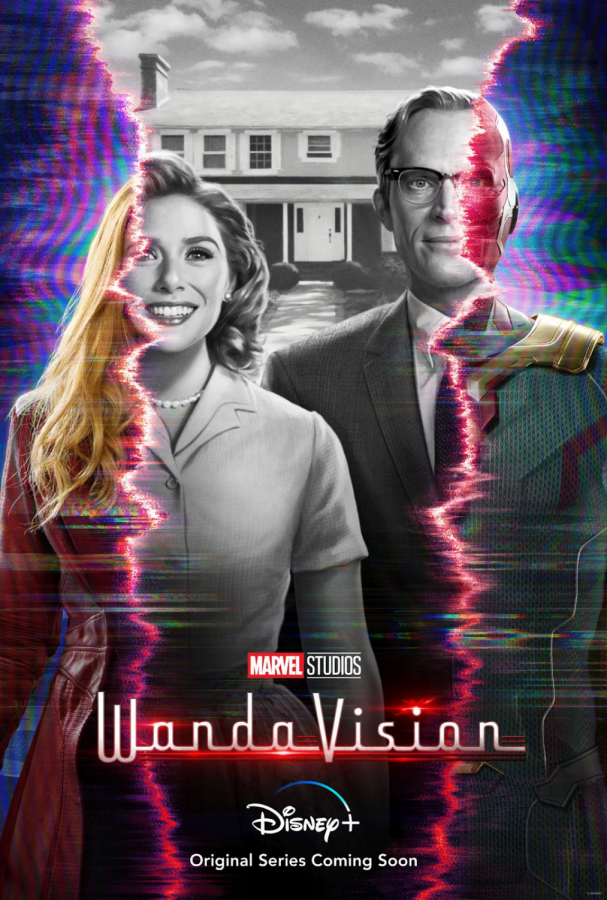WandaVision Review
As the first of Marvel’s television series ends, fans are split on whether or not WandaVision met the quota. Warning: spoilers ahead.
WandaVision’s un-Marvel beginning was a major draw for the audience.
May 17, 2021
WandaVision, the nine episode series featuring Wanda and Vision (as hinted by the name), is set in a sitcom world where the audience go through a mystery and find out what truly happened after the events of “Endgame.” As the first thing Marvel released since it’s big phase-three finale, it was strange to see the franchise continue on in the shape of a Marvel TV show made to look and feel like a sitcom. It became a draw to the show for many people as it was just so different from Marvel. The mystery, the little disturbances in the calm show, was welcomed by many. It intrigued the audience and left us wondering what could be next.
The show starts off without any sort of major plot line. It simply had characters going through funny events in the sitcom style, and trying to impress their new town. As the show progressed, though, the audience saw a mystery peeking through the sitcom world. For a start, there were the different time switches that changed the characters, style, buildings, and even changing from black and white. At the end of episode three, “Now in Color”, the audience sees the outside world for the first time within the show, and finally in episode four, “We Interrupt This Program”, the audience learns what is really going on. They are introduced to new characters that aren’t stuck to being the sitcom type of characters you would normally see on the show. Instead, there are real people, and there the audience gets their first glimpse into the major plot line of the show. From that one instance, multiple subplots move with the major plot and carry on until the end of the show.
While this is a very interesting idea at a first glance, what it really means is that the original hook of the show ends. And yes, it did have to end at some point and the mystery had to be opened up for a climax. However, in order to keep people interested you have to have a strong plot. And originally it did. It still kept some aspects of the original hook even though the audience got introduced to what really happened and kept the same creepy tone as the episodes before. It was a different show that didn’t really have a villain and yet kept going strong. And then on episode seven, the audience are introduced to the real “villain” of the show. The one who had no sort of quality that had us feel they weren’t the bad guy.
By this point, it stopped being WandaVision, or at least the one the audience was watching before. What changed is that, while Wanda may have trapped all the people within her hex, she didn’t know what she was doing and was dealing with grief. Wanda as a character within this show connects with many. Her arc has real emotion to it. She is coming around to the fact that Vision is dead. But even more than that, she has reached her breaking point. All her life she experienced so much pain and death. Her parents, her brother, and now, her beloved. The entire reason for the sitcom was because she grew up learning English through watching them. It’s her tie to her family as a whole. It may not be an excuse, but to the audience it proves she isn’t just the villain. After all, the show is really about her and her time going through this amazing sitcom world.
The show goes strong at the show’s beginning, however this does not stay. After this exact point, it lost all the mystery and the creepiness that the show was built on, which led to a more Marvel-like last two episodes that seemed to end the great show on the lowest point. It abandoned the show’s identity for a climax seen in almost every single superhero movie. It disappoints that such a unique show has to end on such a normalized climax. It isn’t bad or even mediocre, but underwhelming and disappointing considering the favorite thing to do after an episode: looking for easter eggs.
What Marvel truly does best is to give small things for fans to obsess over. A small detail that didn’t have to be there which could mean so much. An easter egg for what may come. WandaVision was no exception to this either. Small things like a bug on the wall and big things like a recast led to mass speculation on what this could mean for the MCU, usually sprouting from a hint in the comics. And while these did bring a lot more interest to the show, they left fans even more disappointed in the end. For example, the Pietro seen in Age Of Ultron was recasted by Pietro from the XMen movies. Obviously, this caused many to think they would introduce the XMen from this show, which led to crazy interdimensional theories.
WandaVision started with an idea. A special, unique way to make a show. The show has character and charm, with great takes on sitcoms, and a Marvel-worthy main plot, hidden beneath the surface. Nevertheless, throughout the show it starts to lose that special quality. It loses consistency, and bleeds towards the end, showing the normal Marvel side of things. Overall, a great show that just loses itself in the end.












